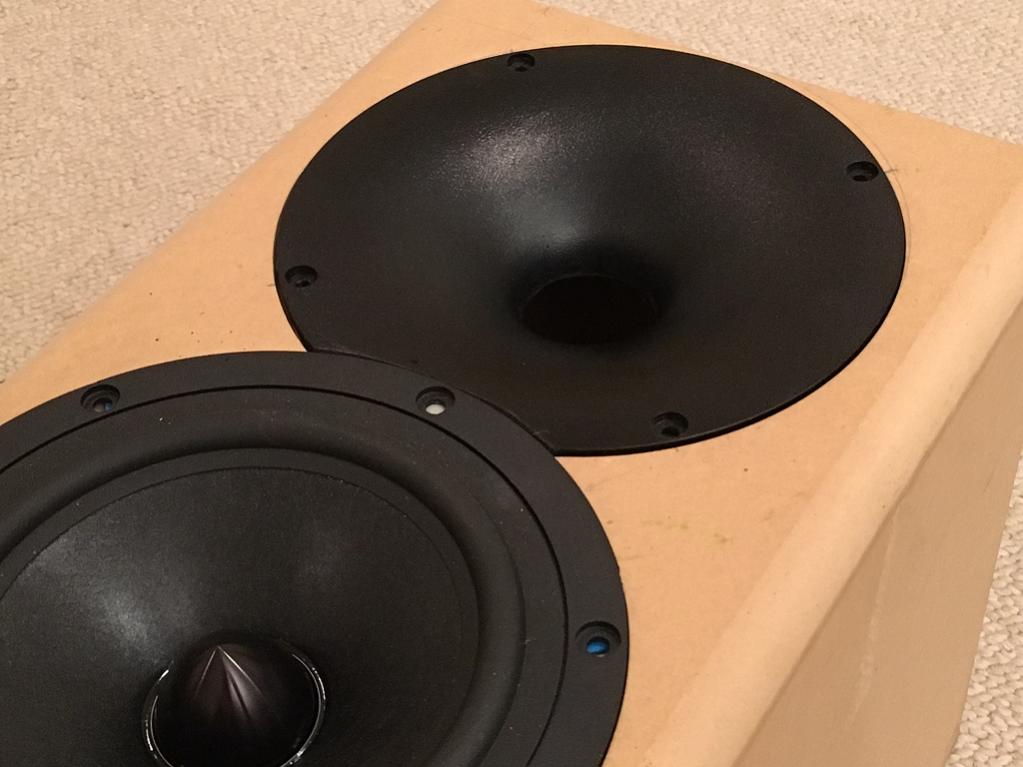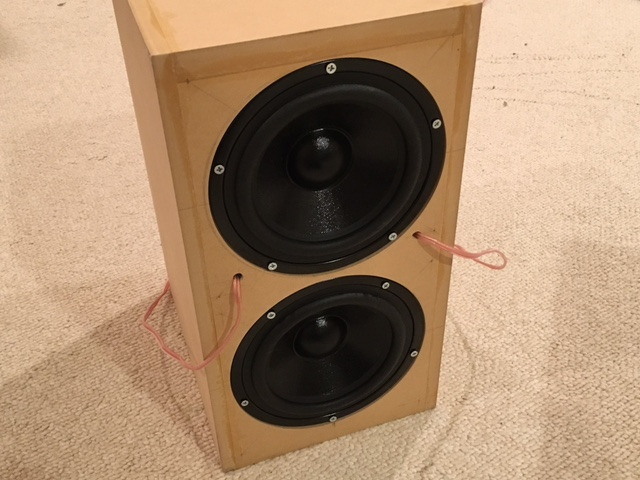The use of cross piece makes the box a short heavily tapered half-wave TL, and acts as a good brace.
I have usually seen these in mid enclosures with an opening at the “point” — a quarter-wave line — usually damped until aperiodic.
dave
I have usually seen these in mid enclosures with an opening at the “point” — a quarter-wave line — usually damped until aperiodic.
dave
Hi Mitch- very much appreciate your review of the SPK 5 I was wondering what you thought of Dirac? I know you’re comfortable with DSP so how did your results compare to Accourate or Audiolense? I ask because I’m toying with getting a Minidsp Studio because it would handle all convolutions with Dirac and my wife and kids wouldn’t have to know anything to play theIr stuff
Thanks!
Tim
Hi Tim, sorry I missed this until now. I evaluated Dirac 2.0 and a review will be up on Audiophile Style in Feb. It is definitely easy to use and hard to mess up 🙂 Using it for a partial correction up to 500 to 600 Hz is a no brainer, works very well. Note I used the PC version, so don't know what limitations, if any, are in the miniDSP unit.
Also as you can see, works very well with a full range correction, but does lack the flexibility like Audiolense or Acourate to adjust frequency dependent windowing parameters to be able to back off the high frequency correction. So it can, "to my ears" sound a bit "over corrected." But I would say sounds better than no correction. In the overall scheme of things, it is a small issue, and perhaps many folks won't notice or even prefer it. So take that with a grain of salt. My review will point out the finer details, but for a no muss no fuss solution that just works as simple as possible, hard to go wrong. Hope that helps.
Anyone built the 15L box?
https://purifi-audio.com/wp-content/uploads/2019/12/SPK5-App-Note.pdf
I evaluated the 15L SPK4 version see attached. Excellent response to 32 Hz. I expect the SPK5 box to be a refinement of SPK4...
Attachments
What do you think about using an Waveguide WG-300 with Peerless DX25TG09-04?
To cut the cost a bit?
Test Peerless DX25TG09-04 (XD-270 F / 4) on the waveguide
To cut the cost a bit?
Test Peerless DX25TG09-04 (XD-270 F / 4) on the waveguide
Any word on whether Purifi is planning a digital-input, DSP-based, multi-channel version of this technology, similar to the Hypex offerings?
What do you think about using an Waveguide WG-300 with Peerless DX25TG09-04?
To cut the cost a bit?
Test Peerless DX25TG09-04 (XD-270 F / 4) on the waveguide
Interesting idea to use WG-300. It will provide nice wide even dispersion and mechanical setback for better time alignment. I used it with RS28F and it works really well.

Here are the polars when crossed at 1kHz with RS180P (with approx eyeballed angles):
I even have them mounted in 0.56cu ft cabinets with dual passive radiators on back. That would be incredible if it were a drop in fit.
Edit: I just checked diameters of RS180 and it looks like it’s 4mm larger on bezel OD and 2mm larger on cutout OD, so theoretically, the Purifi 6.5 could be just dropped in with a slight gap on bezel. That’s a 0.56 Cu ft Denovo flat pack cabinet from PE. That can really save some time on cabinet building and costs. I just need to make the XO now but that’s easy as this driver is smooth and wide bandwidth.
Front:

PR’s on Back:

Last edited:
I even have them mounted in 0.56cu ft cabinets with dual passive radiators on back. That would be incredible if it were a drop in fit.
Edit: I just checked diameters of RS180 and it looks like it’s 4mm larger on bezel OD and 2mm larger on cutout OD, so theoretically, the Purifi 6.5 could be just dropped in with a slight gap on bezel. That’s a 0.56 Cu ft Denovo flat pack cabinet from PE. That can really save some time on cabinet building and costs. I just need to make the XO now but that’s easy as this driver is smooth and wide bandwidth.
What is the benefit with passive radiator compared to tubes?
And are there any alternativ box without the complex tube but still pretty small?
What is the benefit with passive radiator compared to tubes?
And are there any alternativ box without the complex tube but still pretty small?
Vents leak high frequency noise more, tend to be more resonant, unload more below tuning, and PRs usually have higher output capability without vent wind noise.
Subjectively they're usually "tighter" or "cleaner" than vents, but a well implemented vent can avoid many of the above issues without the added cost of PRs.
Also, if you live in the country, vents are a great way for critters to get into a cab.
xrk971 and badman make good comments on passive radiators. I have yet to do my first PR design outside CAD simulations. Running sims on PTT6.5W04-01A woofer plus PTT6.5PR-01A PR in UniBox I find results that make we wish for more real world hands on experience with PR systems.
A single PTT6.5PR-01A PR runs out of excursion capability before the woofer, dual PR looks much better. That's pricey with the PTT6.5PR so xrk971 suggestion of value priced PRs is attractive. Using non-Purifi PRs I would be tempted to go with larger diameter given that to me the big draw of the PTT6.5PR is it shares the woofers' very large for class Xmax. Looking at PRs on Parts Express I was reminded it is easy to spend $250US on the good ones that match the good woofers.
It seems several of the design trade offs tend towards settling for less than ideal PR air displacement capability with the upside being extended bass shelf alignments with Fb to 25 Hz (!!!) that might only take 20 to 30 watts below 30 Hz before maxing out the PR. In a 25L enclosure PTT6.5W04-01A woofer plus PTT6.5PR-01A PR does ~92 dB of bass at ~27 Hz. On music that will be amazing. To me the great unknown is if that system is hit with 50 watts at 25 Hz does the PR make nasty 'clack', 'clack', 'clack' sounds or simply soft limit output?
A single PTT6.5PR-01A PR runs out of excursion capability before the woofer, dual PR looks much better. That's pricey with the PTT6.5PR so xrk971 suggestion of value priced PRs is attractive. Using non-Purifi PRs I would be tempted to go with larger diameter given that to me the big draw of the PTT6.5PR is it shares the woofers' very large for class Xmax. Looking at PRs on Parts Express I was reminded it is easy to spend $250US on the good ones that match the good woofers.
It seems several of the design trade offs tend towards settling for less than ideal PR air displacement capability with the upside being extended bass shelf alignments with Fb to 25 Hz (!!!) that might only take 20 to 30 watts below 30 Hz before maxing out the PR. In a 25L enclosure PTT6.5W04-01A woofer plus PTT6.5PR-01A PR does ~92 dB of bass at ~27 Hz. On music that will be amazing. To me the great unknown is if that system is hit with 50 watts at 25 Hz does the PR make nasty 'clack', 'clack', 'clack' sounds or simply soft limit output?
Looking at PRs on Parts Express I was reminded it is easy to spend $250US on the good ones that match the good woofers.
The RSS265PR should be more than a match for a single Purifi, and is ~$75. Vd=855 cm^3 vs ~133cm^3 for the driver. It's too bad they don't have an 8" RSS pr - it would probably be ideal.
A 10in dia PR makes the speaker box big like a 10in woofer box. Use two 6.5in PR’s of similar stroke to achieve the recommended double the cone area and displacement rule of thumb. The smaller 6.5in aluminum cone ones would probably work fine. Not quite 10mm but only $25ea.
Link seems broken when accessed from here (Germany)..
Look up youtube for "Bending PVC Pipes" - all sorts of tutorials on how to get cheap installation pipes for water etc... from Home Depot to get in shape - all you need is a heat gun and patience...
Look up youtube for "Bending PVC Pipes" - all sorts of tutorials on how to get cheap installation pipes for water etc... from Home Depot to get in shape - all you need is a heat gun and patience...
Question Re: PR Offering from Purifi
It seems that some practical reason is being missed here and I'm wondering...
If Purifi has put so much (1) careful development into this driver AND
(2) knows that the vent size or length is a problem for a small cabinet design so they decide to offer a passive radiator...
Why would they offer a radiator 1/2 the size required especially when there is rumor of a larger driver in the works.
Seems they would wait and offer a passive for the 6.5 based on a larger driver frame.
Or is it possible that the offered PR will be fine with the correct thinking?
People who have built the SPK5 demo seem damned impressed even with already mentioned compromises in the design.
I don't know but am curious.
Perhaps in room response of a single driver/single passive radiator design gets "there" even if modeling shows room for more?
It seems that some practical reason is being missed here and I'm wondering...
If Purifi has put so much (1) careful development into this driver AND
(2) knows that the vent size or length is a problem for a small cabinet design so they decide to offer a passive radiator...
Why would they offer a radiator 1/2 the size required especially when there is rumor of a larger driver in the works.
Seems they would wait and offer a passive for the 6.5 based on a larger driver frame.
Or is it possible that the offered PR will be fine with the correct thinking?
People who have built the SPK5 demo seem damned impressed even with already mentioned compromises in the design.
I don't know but am curious.
Perhaps in room response of a single driver/single passive radiator design gets "there" even if modeling shows room for more?
- Home
- Loudspeakers
- Multi-Way
- Purifi Audio by Bruno Putzeys and friends.